National Highlights:
|
Contents of this Section: |

 North American 500 Mb Maps
North American 500 Mb Maps
| The mean upper-air pattern during October was generally characterized by positive height anomalies over portions of the West and Southwest while an area of negative height anomalies was over the extreme north central portion of the country. Monthly mean height anomalies in the rest of the country were near zero. A persistent area of high pressure the latter half of the month brought much above normal temperatures to many Southwestern states while troughiness in the center of the nation was associated with above normal wetness. Temperatures from Texas eastward to the Atlantic were below normal.
Additional information on hydrometeorological analysis and forecasting can be found at the Hydrometeorological Prediction Center's Web Page. The principles behind the 500 mb flow are briefly explained here. |
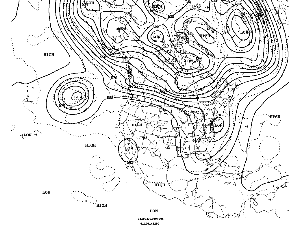 animation |

 National Temperatures
National Temperatures
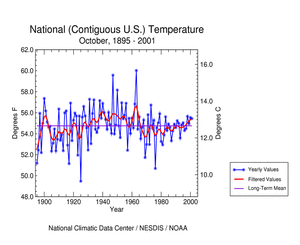 larger image |
The graph to the left shows monthly mean temperature averaged across the contiguous United States based on long-term data from the U.S. Historical Climatology Network (USHCN). The 2001 value is estimated from preliminary Climate Division data using the first difference approach. October 2001 ranked as the thirty-eighth warmest October in the 1895 to present record, and fell just within the middle third of the historical distribution. The preliminary nationally averaged temperature was 55.4° F (13.0° C) which was 0.7° F (0.4° C) above the long-term mean. The October temperature values from 1895 through 2001 are available. |
October temperatures in the last eight years have hovered near the mean.
 Lower Tropospheric Temperatures
Lower Tropospheric Temperatures
| Data collected by NOAA's TIROS-N polar-orbiting satellites and adjusted for time-dependent biases by NASA and the Global Hydrology and Climate Center at the University of Alabama in Huntsville indicate that temperatures in the lower half of the atmosphere (lowest 8 km) were above average over the U.S. for October 2001. The average lower tropospheric temperature over the continental U.S. was 0.4° F (0.2° C) above the 1979-1998 mean. Five of the last seven Octobers have been above the mean. | 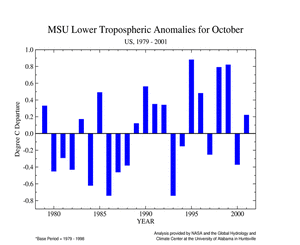 larger image |
 Temperature Departures
Temperature Departures
The map below, based on approximately 250 airport stations, shows departures from the 1961-1990 normal temperatures for October 2001.
| In general, temperatures over most of the Northeast and Southwest were warmer than average. The largest positive anomalies (greater than 3.6° F or 2° C) occurred in Nevada through Arizona and New Mexico. Positive anomalies also occurred in many Northeastern states. Negative anomalies occurred from Washington eastward to Minnesota with the largest negative anomalies (less than 3.6° F or 2° C) occurring in the southern quarter of the country. Alaska was cooler than average while Puerto Rico and Hawaii were near normal. |
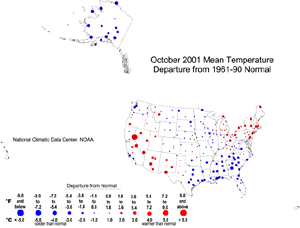 larger image |
Maps showing how the temperature anomalies varied day-to-day and how the day-to-day temperature variability compares to the long-term average are available. For further regional analysis, view NCDC's regional page.
 Standardized Temperature Anomalies
Standardized Temperature Anomalies
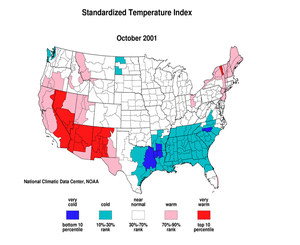 larger image |
Positive standardized temperature anomalies for October 2001 were generally located in the southwestern quarter of the nation and in portions of the Northeast. Negative anomalies were present in the southeast quarter of the country, western North Dakota and western Washington. The adjacent animated map shows the geographical pattern of temperature anomalies for the last 12 months compared to a base period of 1931-1990.
For further regional analysis, view NCDC's regional page. |

 National Precipitation
National Precipitation
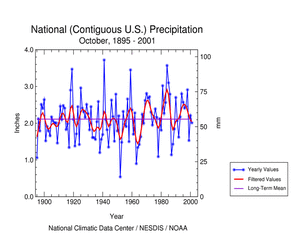 larger image |
The graph to the left is a time series depicting precipitation averaged across the nation. Based upon preliminary precipitation data, October 2001 was near average, ranking forty-sixth driest in the 1895 to present record. While nationally averaged precipitation was near the long term mean, there was regional variability. Indiana was notably wet receiving much above normal precipitation for the month. A severe weather outbreak occurred on the 24th affecting Michigan southward to the Tennessee Valley. There were over 500 reports of severe weather including 20 tornadoes, 100 reports of hail three-quarters of an inch (1.9 cm) or larger, and more than 400 reports of wind gusts in excess of 57 mph (25 m/sec). |
For further regional analysis, view NCDC's regional page.
 Precipitation Anomalies
Precipitation Anomalies
| The map to the right, based on approximately 250 airport stations, shows October 2001 total precipitation as a percent of the 1961-1990 station normals. Above normal precipitation generally occurred in the Northwest and from Michigan southward to the Gulf of Mexico. The rest of the country was mostly dry including Puerto Rico. Conditions in Alaska and Hawaii were mixed. For further regional analysis, view NCDC's regional page. |
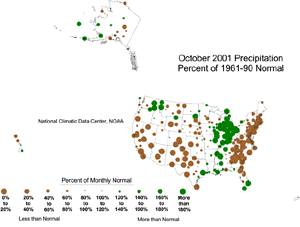 larger image |
 National Snow Cover
National Snow Cover
On October 24th Grand Forks, North Dakota received an October-record 10.8 inch snowfall. Fargo, North Dakota received 4.9 inches from the same system. Snow squalls also developed in the Great Lakes region especially in Michigan's Upper Peninsula.
 References
References
Current data are based on preliminary reports from River Forecast Center stations and First and Second Order airport stations obtained from the National Weather Service (NWS) Climate Prediction Center and real time Global Telecommunications System (GTS) monthly CLIMAT summaries. THE CURRENT DATA SHOULD BE USED WITH CAUTION. These preliminary data are useful for estimating how current anomalies compare to the historical record, however the actual values and rankings for the current year may change as the final data arrive at NCDC and are processed.
The following NCDC datasets are used for the historical U.S. data: the climate division drought database (TD-9640), and the hurricane datasets (TD-9636 and TD-9697). It should be noted that the climate division drought database consists of monthly data for 344 climate divisions in the contiguous United States. These divisional values are calculated from the 6000+ station Cooperative Observer network.
 NOAA's National Centers for Environmental Information
NOAA's National Centers for Environmental Information
